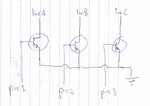STTrife
Newbie level 5
I am working on a small hobby project and I ran into something that I don't understand, I hope someone can explain it.
I'm trying to control a remote control device with a PIC. Now I managed to make this work, with the help of some diagrams I found online, but there's one aspect I don't get (why it's working).
I tried it with the off and on switch on the remote. There are 3 pins/lines involved with these buttons. (say line A, B, C). When line A and B are connected, the on-button is activated, when line A and C are connected, the off button is activated.
Line A has +3.3 v over B and also over C. No voltage between B and C
Now to control this, I found a design with a PIC and 3 transistors, which works, I have attached the diagram:

The two systems (remote and PIC) have separate power supplies. The ground in the diagram is only the ground of the PIC, not the remote control.
Now I understand that when I set Pin A and Pin B HIGH, that the first and second transistors are 'open', but how can current flow from line A to line B? It would have to go trough the second transistor in the wrong direction... right??? how is that possible?
Thanks for any information!
I'm trying to control a remote control device with a PIC. Now I managed to make this work, with the help of some diagrams I found online, but there's one aspect I don't get (why it's working).
I tried it with the off and on switch on the remote. There are 3 pins/lines involved with these buttons. (say line A, B, C). When line A and B are connected, the on-button is activated, when line A and C are connected, the off button is activated.
Line A has +3.3 v over B and also over C. No voltage between B and C
Now to control this, I found a design with a PIC and 3 transistors, which works, I have attached the diagram:

The two systems (remote and PIC) have separate power supplies. The ground in the diagram is only the ground of the PIC, not the remote control.
Now I understand that when I set Pin A and Pin B HIGH, that the first and second transistors are 'open', but how can current flow from line A to line B? It would have to go trough the second transistor in the wrong direction... right??? how is that possible?
Thanks for any information!
![Logic-Diagram-of-ULN2003[1].jpg Logic-Diagram-of-ULN2003[1].jpg](https://www.edaboard.com/data/attachments/58/58222-13ac6710c3f427cac1e56d992cc94a84.jpg)